新版牛津译林小学英语4A Unit3第二课时
- 格式:doc
- 大小:48.00 KB
- 文档页数:4
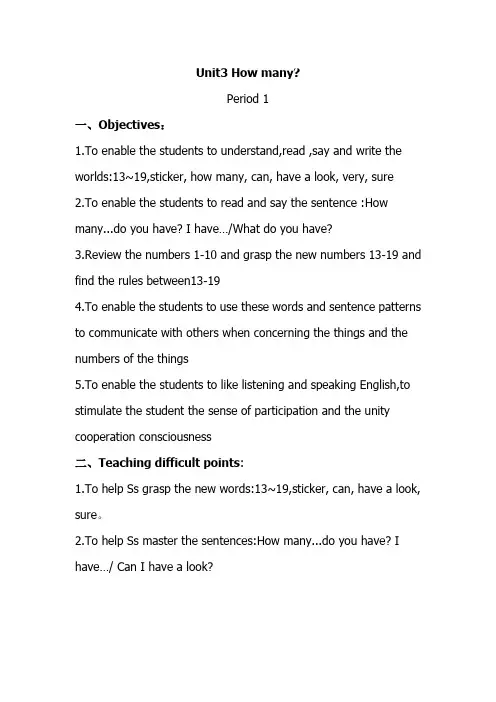
Unit3 How many?Period 1一、Objectives:1.To enable the students to understand,read ,say and write the worlds:13~19,sticker, how many, can, have a look, very, sure2.To enable the students to read and say the sentence :How many...do you have? I have…/What d o you have?3.Review the numbers 1-10 and grasp the new numbers 13-19 and find the rules between13-194.To enable the students to use these words and sentence patterns to communicate with others when concerning the things and the numbers of the things5.To enable the students to like listening and speaking English,to stimulate the student the sense of participation and the unity cooperation consciousness二、Teaching difficult points:1.To help Ss grasp the new words:13~19,sticker, can, have a look, sure。
2.To help Ss master the sentences:How many...do you have? I have…/ Can I have a look?3. To enable the students to use these words and sentence patterns to communicate with others when concerning the things and the numbers of the things三、Teaching AidsPictures,Power point,Tape recorder四、Teaching ProceduresStep 1 Warm up1.Sing the song “ Do you like purple grapes?”(Review the numbers students have learned and arouse their interest and attention in class.)2. Greetings and free talkThe teacher says that she has some grapes here and ask the students “Do you like the grapes” and then teacher and students count the grapes together or the things(pencils,rubbers,rulers...) (use the things that ss are familiar with to review the numbers they have learned )3.The teacher says that she has a pencil and ask the students do they have and how many pencils do they have and then count the pencils together and then the teacher continues to ask the students Do you have...and maybe the students do not have ,then the teacher ask “what do they have”,students may answer”I have...”then teacher asks “how many ..do you have”,students answer”I have ...”4.The teacher leads the students to ask when they want to know the numbers and then teach them use the sentence”How many?”,at the same time can point the title”How many?’(get ss to used to the new text,get ss actively involved in lesson) Step 2 Presentation1.Work in pairsThe teacher says she has some things and let the students to guess,(they are toys,animals,fruits) lead the students to use the sentence “Do you have any...?”to guess the thing and then continues to use “How many … do you have?”to complete the dialoguee the same way to introduce the 13 oranges and teach the number thirteen 133.The teacher gives a “?”(sticker)and let the ss to guess and then let them ask with the sentence“ What do you have?”Teach and practice:What do you have?Teach stickers(贴纸)(use the prediction to train ss’s thought)4.Let the students ask” How many stickers do you have?”and the teacher have prepared so many stickers then lead the ss when they want to know more numbers they can use number....(present number1-19 in two groups) and lead them to find the rules(Encourage them to conclude by themselves and develop their ability to think independently)Can I have a look?Can I have one?teach:can, have a look and the answer Sure.(train ss to read carefully to find the sentence in the text and can guess what the meaning is)4.Read the storya. read after the recorderb. read the story togetherc. Role playStep4.Consolidation1.Ask and answer with your partner.A: Do you have a ruler? B: Yes, I Do.A: How many rulers do you have? B: I have…A:Can I have one? B: Sure.A:Thanks.(by practicing to consolidate)2.T: What do you learn from this lesson?a.当你想问对方有什么可以问:b.当你询问对方拥有物品的数量,可以问:(How many)c.当你想询问对方是否能看一下,可以说:(Can I have a look?) (encourage the ss to think about the text and what they have read,and practice the language they met)Step5 Homework1. Read the story after the tape more than five times2.Spell and remember the numbers from 1~19五、Blackboard designUnit3 How many?How many ... do you have?...Do you have any...?Yes, I do. /No, I don’t.What do you have?I have...。
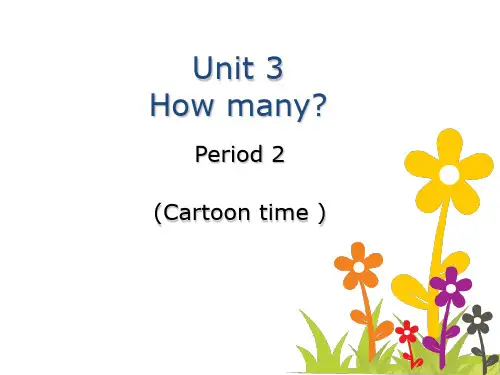
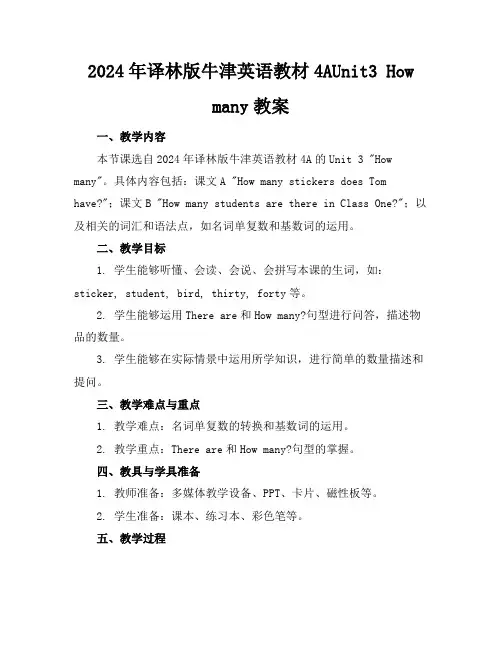
2024年译林版牛津英语教材4AUnit3 Howmany教案一、教学内容本节课选自2024年译林版牛津英语教材4A的Unit 3 "How many"。
具体内容包括:课文A "How many stickers does Tom have?";课文B "How many students are there in Class One?";以及相关的词汇和语法点,如名词单复数和基数词的运用。
二、教学目标1. 学生能够听懂、会读、会说、会拼写本课的生词,如:sticker, student, bird, thirty, forty等。
2. 学生能够运用There are和How many?句型进行问答,描述物品的数量。
3. 学生能够在实际情景中运用所学知识,进行简单的数量描述和提问。
三、教学难点与重点1. 教学难点:名词单复数的转换和基数词的运用。
2. 教学重点:There are和How many?句型的掌握。
四、教具与学具准备1. 教师准备:多媒体教学设备、PPT、卡片、磁性板等。
2. 学生准备:课本、练习本、彩色笔等。
五、教学过程1. 导入:教师通过展示一组图片(如:贴纸、小鸟、学生等),引导学生用中文描述图片内容,为新课内容做铺垫。
2. 新课内容展示:教师播放课文A的录音,让学生边听边跟读,学习新词汇和句型。
然后,教师对名词单复数和基数词进行讲解,并举例说明。
3. 例题讲解:教师给出几个例题,如:“There are thirty students in our class. How many students are there?”,引导学生运用所学知识进行解答。
4. 随堂练习:教师分发练习纸,让学生完成相关的练习题。
同时,教师进行个别辅导,解答学生的疑问。
5. 小组活动:学生分成小组,用所学知识进行数量描述和问答练习。
教师巡回指导,给予评价和建议。
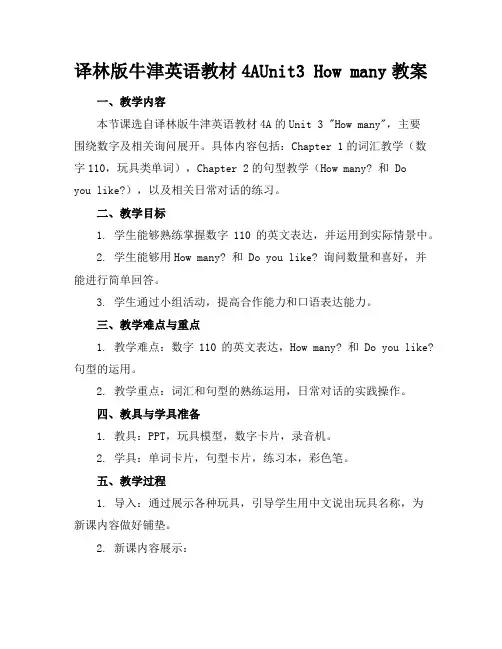
译林版牛津英语教材4AUnit3 How many教案一、教学内容本节课选自译林版牛津英语教材4A的Unit 3 "How many",主要围绕数字及相关询问展开。
具体内容包括:Chapter 1的词汇教学(数字110,玩具类单词),Chapter 2的句型教学(How many? 和 Doyou like?),以及相关日常对话的练习。
二、教学目标1. 学生能够熟练掌握数字110的英文表达,并运用到实际情景中。
2. 学生能够用How many? 和 Do you like? 询问数量和喜好,并能进行简单回答。
3. 学生通过小组活动,提高合作能力和口语表达能力。
三、教学难点与重点1. 教学难点:数字110的英文表达,How many? 和 Do you like? 句型的运用。
2. 教学重点:词汇和句型的熟练运用,日常对话的实践操作。
四、教具与学具准备1. 教具:PPT,玩具模型,数字卡片,录音机。
2. 学具:单词卡片,句型卡片,练习本,彩色笔。
五、教学过程1. 导入:通过展示各种玩具,引导学生用中文说出玩具名称,为新课内容做好铺垫。
2. 新课内容展示:a. 教师展示PPT,呈现数字110和对应的英文单词,引导学生跟读。
b. 教师利用玩具模型,展示How many? 和 Do you like? 句型,让学生模仿并练习。
3. 例题讲解:教师给出一个例题,如:“How many cars do you like?”,引导学生用所学句型回答。
4. 随堂练习:学生两人一组,用句型卡片进行问答练习。
5. 小组活动:每组选择一个主题,如“动物园”、“超市”等,运用所学词汇和句型进行对话创编和表演。
六、板书设计1. 数字110和对应的英文单词。
2. How many? 和 Do you like? 句型。
3. 各小组的主题和对话示例。
七、作业设计1. 作业题目:a. 抄写数字110的英文单词,每个3遍。
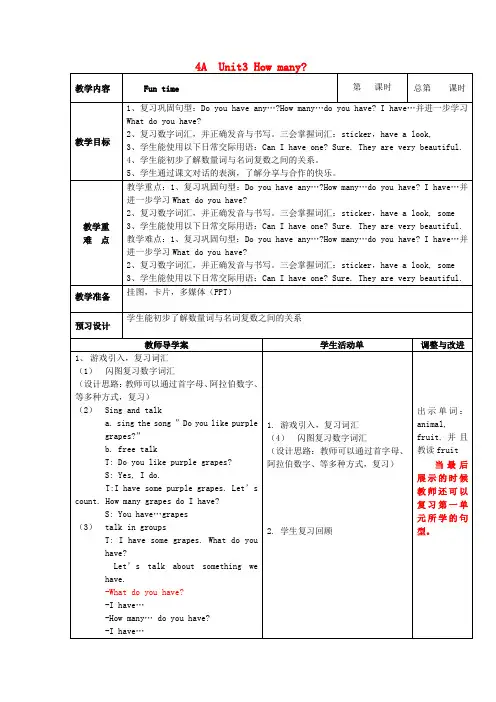
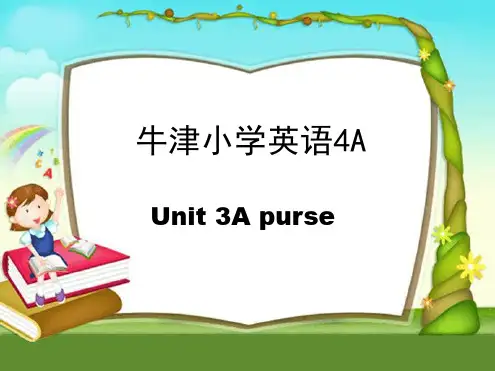
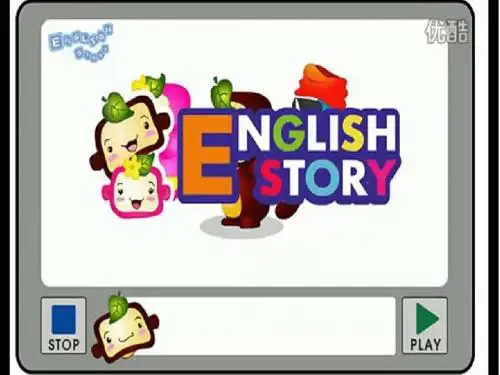
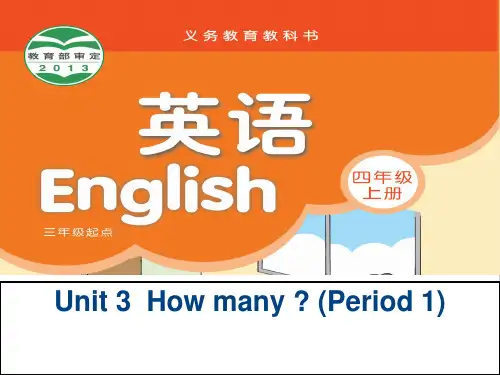
![[译林版]4A Unit3 Unit3 How many(P2)优秀课件](https://uimg.taocdn.com/6293cb982e3f5727a4e9627f.webp)
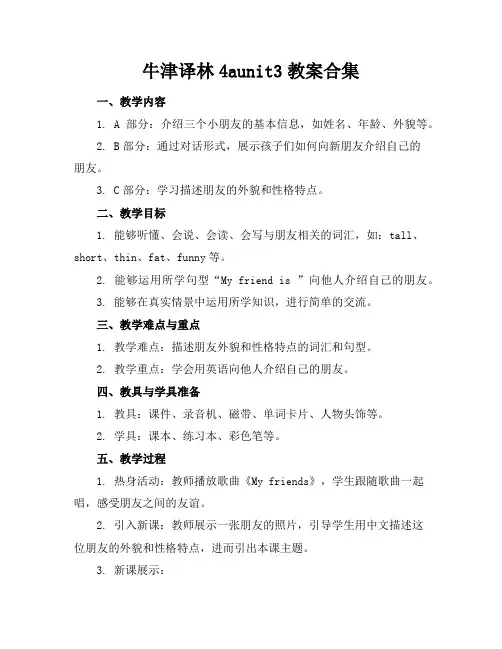
牛津译林4aunit3教案合集一、教学内容1. A部分:介绍三个小朋友的基本信息,如姓名、年龄、外貌等。
2. B部分:通过对话形式,展示孩子们如何向新朋友介绍自己的朋友。
3. C部分:学习描述朋友的外貌和性格特点。
二、教学目标1. 能够听懂、会说、会读、会写与朋友相关的词汇,如:tall、short、thin、fat、funny等。
2. 能够运用所学句型“My friend is ”向他人介绍自己的朋友。
3. 能够在真实情景中运用所学知识,进行简单的交流。
三、教学难点与重点1. 教学难点:描述朋友外貌和性格特点的词汇和句型。
2. 教学重点:学会用英语向他人介绍自己的朋友。
四、教具与学具准备1. 教具:课件、录音机、磁带、单词卡片、人物头饰等。
2. 学具:课本、练习本、彩色笔等。
五、教学过程1. 热身活动:教师播放歌曲《My friends》,学生跟随歌曲一起唱,感受朋友之间的友谊。
2. 引入新课:教师展示一张朋友的照片,引导学生用中文描述这位朋友的外貌和性格特点,进而引出本课主题。
3. 新课展示:(1)教师出示单词卡片,引导学生学习新词汇。
(2)教师播放课文录音,学生跟读,学习句型“My friendis ”。
(3)教师组织学生进行角色扮演,练习用所学知识进行交流。
4. 随堂练习:学生完成课本上的练习题,巩固所学知识。
5. 小结:教师带领学生回顾本节课所学内容,检查学生对词汇和句型的掌握情况。
六、板书设计1. 课题:Unit 3 My friends2. 重点词汇:tall、short、thin、fat、funny等3. 重点句型:My friend is七、作业设计1. 作业题目:请用英语向你的同桌介绍你的一个朋友,包括外貌和性格特点。
2. 答案示例:My friend is tall and thin. He is very funny. We like playing football together.八、课后反思及拓展延伸1. 课后反思:教师应关注学生在课堂上的表现,了解学生对词汇和句型的掌握情况,及时调整教学方法,提高教学效果。
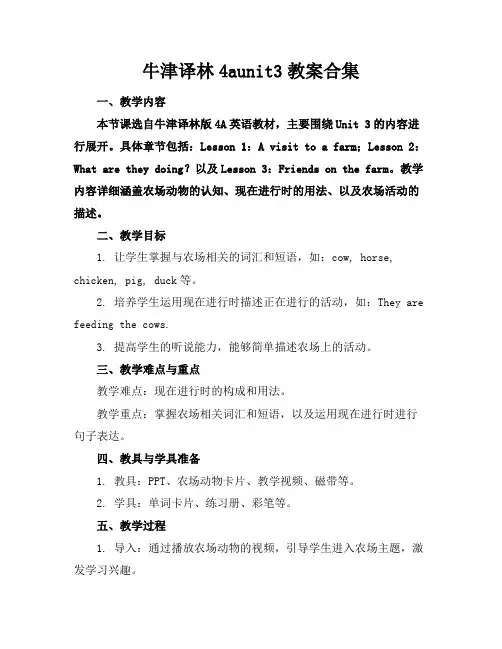
牛津译林4aunit3教案合集一、教学内容本节课选自牛津译林版4A英语教材,主要围绕Unit 3的内容进行展开。
具体章节包括:Lesson 1:A visit to a farm;Lesson 2:What are they doing?以及Lesson 3:Friends on the farm。
教学内容详细涵盖农场动物的认知、现在进行时的用法、以及农场活动的描述。
二、教学目标1. 让学生掌握与农场相关的词汇和短语,如:cow, horse, chicken, pig, duck等。
2. 培养学生运用现在进行时描述正在进行的活动,如:They are feeding the cows.3. 提高学生的听说能力,能够简单描述农场上的活动。
三、教学难点与重点教学难点:现在进行时的构成和用法。
教学重点:掌握农场相关词汇和短语,以及运用现在进行时进行句子表达。
四、教具与学具准备1. 教具:PPT、农场动物卡片、教学视频、磁带等。
2. 学具:单词卡片、练习册、彩笔等。
五、教学过程1. 导入:通过播放农场动物的视频,引导学生进入农场主题,激发学习兴趣。
2. 新课内容展示:展示Lesson 1的PPT内容,学习农场动物词汇,并进行互动问答。
3. 例题讲解:讲解现在进行时的构成和用法,举例说明。
4. 随堂练习:分组进行口语练习,用现在进行时描述农场上的活动。
6. 课后作业布置:布置作业,巩固所学知识。
六、板书设计1. 牛顿译林4A Unit 3板书设计:农场动物词汇:cow, horse, chicken, pig, duck现在进行时:be (am/is/are) + doing例句:They are feeding the cows.七、作业设计1. 作业题目:(1)抄写本节课所学的农场动物词汇,每个写5遍。
2. 答案:(1)见附件。
八、课后反思及拓展延伸1. 反思:关注学生的学习反馈,对教学方法和节奏进行调整,以提高教学效果。
Module3 Unit 2 (第一课时)I.Copy the sentences (正确抄写下列句子):grandma I have a new friend her name’s Nancy ________________________________________________________________II.Change the words (按要求写单词):rge (同义词) _________ 6. beside (近义词) _________2.bottle (同类词) _________ 7. shop (同类词) _________3.many (同义词) _________ 8. here(同音词) _________4.dresses (单数)_________ 9. they (宾格) _________5.we (所有格) _________ 10. sharp (反义词) _________III.Choose the best answers.(选择)( )1. __________ a big forest and a small river.A. there isB. there areC. There is( )2. Eddie has got _______ ice-cream. My brother has got ______juice.A. a, someB. an, someC. some, a( )3. Where _________ Alice? On a swing.A. areB. amC. is( )4. __________ is your sister’s skirt? Fifty yuan.A. How oldB. How muchC. How many( )5. Where’s the playground? It’s _________ the tree.A. besideB. inC. under( )6. He’s got some _________.A. toastB. bananaC. flowerIV.Fill in the blanks (用所给词的适当形式填空)1.Those sweets _________ (be) twelve yuan.2.How _________ (many) are these biscuits? They’re eight yuan.3.Two _________ (bottle) of juice, please.4.Their teacher _________ (not like ) crisps.5._________ (there be) much water over there.V. Read and choose (阅读选择)My grandma lives in Suzhou. I’m going to visit her with my mother. We want to buy some food for her. Look at our trolley(手推车). We have got some apples and bananas. We haven’t got any packets of sweets or chocolate because grandma doesn’t like sweet food. In the trolley, there is a long box of coffee and a box of butter. And there are two bottles of jam. The jam is for me because I eat bread with jam for breakfast every morning.( )1. Grandma _________ with me.A. livesB. doesn’t liveC. is( )2. We are in the _________.A. schoolB. homeC. supermarket( )3. Grandma _________ chocolate.A. likesB. wantsC. doesn’t like( )4.She likes to drink_________.A. juiceB. coffeeC. butter( )5.There are some _________ in the trolley. They are for grandma.A. fruitsB. booksC. clothesModule3 Unit 2 (第二课时)I.Read and write (写出划线部分的同类词):1.Look at the fruit. They’re apples, oranges and _________.2.Is there any butter in the packet? No. There’s some _________.3.A pencil case is fifteen yuan. A _________ is three yuan.4.These are triangles. That is a _________.5.I like biscuits. But my mother likes _________.6.Kitty is in the classroom. Lucy is in the _________.7.Your father is a teacher. Your mother is a _________.8.My eyes are big. My _________ is small.II.Fill in the blanks (用所给词的适当形式填空):1.I’ve got some _________ (blouse).2.His sister has got some _________ (sandwich).3.They like bread. Their friend _________ (like) cakes.4.What _________ (have) the boys got? Some chocolate.III.Rewrite the following sentences (按要求写句子):1.They’ve got some robots. (否定句)___________________________________2.I’ve got some flour. (I改成My mother)___________________________________3.The jam is ten yuan. (划线部分提问)___________________________________4.We are behind the garden. (划线部分提问)___________________________________5. Miss Fang likes bread. (一般疑问句,肯定回答)___________________________________ ___________________________________ 6.Judy’s father is a police officer. (划线部分提问)What __________ Judy’s father __________?IV.Read and match (将问题与答案配对)1.Has Danny got an exercise book?( ) A. He’s got a sketch-book.2.Wha t’s Danny got?( ) B. It’s black.3.What colour is the sketch-book?( ) C. It’s in his hand.4.What shape is the sketch-book? ( ) D. It’s twelve yuan.5.Where is the sketch-book?( ) E. No, he hasn’t.6.How much is the sketch-book?( ) F. It’s a square.Module3 Unit 2 (第三课时)I.Copy the sentences (正确抄写下列句子):who’s that boy he’s Eric my deskmate ________________________________________________________________II.Read and write (写出划线部分的同类词):1.The sheep are _________ the grass. The ducks are in the pond.2.Don’t _________ the tree. Don’t pick the flowers.3.The _________ and the flowers are in the plant house.4.There is a swing and a _________ in the park.5. Peter can ski and Mary can _________.6. Stretch your arms and _________ your hands.7. Mr Li is a postman. Mrs Wang is a _________.8. Have you any toast? No, I have some _________.III. Fill in the blanks (用所给词的适当形式填空):1. Please _________ (clean) the blackboard. It’s dirty.2. _________ (not play) in the pond, Eric. It’s dangerous.3. I like _________ (have) a picnic in the park.4. How many _________ (sheep) are there on the farm?5. Their cousin _________ (have) a pair of sunglasses.IV.Choose the best answers(选择):( )1. __________ run in the classroom.A. NotB. Can’tC. Don’t( )2.There is a monkey _________ the tree.A. inB. onC. at( )3. Count the _________, Danny.A. birdB. birdsC. a bird( )4.The girl is _________ the swing.A. inB. onC. to( )5. There is _________ coffee in the glass.A. aB. manyC. much( )6. __________ is the frog? On the leaf.A. HowB. WhatC. Where( )7. It has small _________ sharp teeth.A. andB. butC. of( )8. What _________ Kitty’s brother got? Some robots.A. hasB. haveC. isModule3 Unit 2 (第四课时)I.Read and write (写出划线部分的同类词):1.Alice is on the swing. Danny is _________ the slide.2.The restaurant is big and the _________ is large.3.Don’t _________ in the pond, Ben. Don’t pick the flower, Eddie.4.There is a big cupboard and some _________ in the kitchen.5.A larger packet of sweets is twelve yuan. A small packet of sweets is _________ yuan.6.There are some dolls, balls and _________ in the toy shop.7.We can play in the playground. We can read in the _________.II.Fill in the blanks (用所给词的适当形式填空):1.How many _________ (sweater) have you got? I’ve got two.2.Close _________ (you) eyes, Peter.3.These _________ (boy) sketch-books are new.4.I have a friend. _________ (she) name’s Alice.5.How _________ (many) honey is there in the packet?III.Rewrite the following sentences(按要求改写句子)1.Jim, walk on the grass. (否定句)______________________________________ _2.Alice’s got some sweets. (一般疑问句)______________________________________ _3.Danny has got a packet of crisps. (划线部分提问) ______________________________________ _4.Kitty is in the plant house. (划线部分提问)______________________________________ _5.There are sixteen oranges. (划线部分提问)______________________________________ _IV.Read and choose (选择,完成短文):Look_1 _the picture. It’s Ce ntury Park(世纪公园). It’s in Pudong. It’s big and beautiful. There’s a big _2 __in it. Look! The ducks are _3 _the pond. They are swimming. There are some boats on the water, too. Alice is _4 _a swing. She’s happy. Eddie is _5 __a tree. He’s tired. H’s sleeping. The birds are flying in the sky.( )1. A. in B. at C. to( )2. A. fountain B. playground C. pond( )3. A. under B. in C. near( )4. A. on B. in C. under( )5. A. on B. in C. underV.Read and write (阅读短文,填入所缺单词):Look! There are four p_________ in the classroom. Kitty has got some p_________. She can paint. Eddie has got a b_________. He can read it. Peter and John are running. Mr Chen says:’’Don’t r_________ in the classroom.” They boys say s_________ to Mr Chen. Module3 Unit 2 (第一课时)I.Grandma, I have a new friend , her name’s Nancy.II. 1. big 2. bag 3. much 4. dress 5. our 6. close 7. market 8. hear 9. them 10. bluntIII. 1-6. C B C B A AIV.1. are 2. much 3.bottles 4.doesn’t like 5. There isV. 1-5 B C C B AModule3 Unit 2 (第二课时)I.1. pears 2. bread 3. pencil 4. square 5. sweets 6. library 7. worker 8. noseII. 1. blouses 2. sandwiches 3. like 4. haveIII.1. They haven’t any robots.2.My mother have got some flour.3. How much is the jam?4. Where are you?5.Does Miss Fang like bread? Yes, she does.6.is jobIV.1-6 E A B F C DModule3 Unit 2 (第三课时)I.1.Who’s that boy? He’s my deskmate Eric.II. 1. on 2. cut down 3. butterflies. 4. lake 5.swim 6. wave 7. teacher 8. biscuits III.1. clean 2.Don’t play 3. having 4. sheep 5. hasIV.1-8 C A B B C C B AModule3 Unit 2 (第四课时)I.1. on 2. square 3. swim 4. cups 5. eight 6. model planesII.1.sweaters 2. your 3.boys’ 4. Her 5. muchIII.1. Jim, don’t walk on the grass.2.Has Alice got any sweets?3.What has Danny got?4.Where is Kitty?5.How many oranges are there?IV.1-5 B C B A CV. pupils, pictures, book, run, sorry。
译林版牛津英语教材4AUnit3 How many教案一、教学内容本节课选自译林版牛津英语教材4A的Unit 3,主要内容包括:Lesson A(How many?)和Lesson B(Look and say)。
通过学习这两课,学生将掌握询问数量、表达数量的基本句型,以及一些基础数字词汇。
二、教学目标1. 能够听懂、会说、会读、会写本节课所学的数字词汇(one, two, three, four, five, six, seven, eight, nine, ten)和句型(How many ?)。
2. 能够运用所学知识进行询问和回答物品的数量。
3. 能够在真实的语境中运用所学知识进行简单的交流。
三、教学难点与重点教学难点:数字词汇的拼写和句型“How many ?”的运用。
教学重点:掌握数字词汇和句型,能够在实际情景中进行询问和回答。
四、教具与学具准备1. 教具:多媒体课件、图片、数字卡片、小物品(如水果、文具等)。
2. 学具:英语课本、练习本、彩色笔。
五、教学过程1. 导入:通过多媒体展示一个热闹的游乐园场景,引导学生观察并提问:“What can you see in the picture? How many can you see?”,引出本节课的主题。
2. 新课展示:呈现Lesson A的图片,引导学生学习数字词汇(one, two, three, four, five, six, seven, eight, nine, ten)和句型“How many ?”。
3. 例题讲解:讲解如何用所学句型进行询问和回答,结合图片进行示范。
4. 随堂练习:分组进行角色扮演,用所学知识进行询问和回答,教师给予指导与反馈。
5. 巩固拓展:呈现Lesson B的图片,引导学生进行“Look and say”练习,巩固所学知识。
六、板书设计1. 数字词汇:one, two, three, four, five, six, seven, eight, nine, ten。
备课时间年月日上课时间年月日课题Unit 3 How many?总第课时教学目标1、学生能通过比较,了解数词的构词规则2、学生能理解How many后面使用名词复数形式,并能尝试正确运用3、通过各种活动充分激发学生学习英语的积极性本课第 1 课时课型:重点句型: Do you have any…?How many…do you have? I have…教具:录音机,磁带难点3、学生能理解How many后面使用名词复数形式,并能尝试正确运用教学环节与内容修改与反思(1)T: First Let’s count(2)T: Do you find something from these words.a.(设计思路:教师通过让学生比较词汇的拼写,得出后面加teen 的特征)b.(接着教师通过十几与几的比较,让学生找出特殊变化的词汇)(3)T: How many pencils do you have?S: I have…pencils.板书:How many…do you have? I have…教师可以继续延伸使用其他文具进行问答先示范,后同桌对话在进行对话练习前,教师可以提醒学生观察,并总结How many 后面使用单词复数形式T: Do you have any…?S: Yes, I do.T: How many … do you have?S:I have…T: I see.板书:Do you have any…?(4)T: Now Let’s play a guessing game.S: I have….T: How many dolls do you have?S1:… S: No./Yes.T: Now let’s try to ask together.Ss: How many dolls do you have?Chant游戏巩固1,2,3…19,I can count!Do you have any balls? 教师通过数数的过程,学习13-19的数字这个过程,教师主要应该注意学生发音上的纠正)教师通过同桌问答,练习新句子教师提供生活真实情景,如屏幕上出现娃娃、书等物,让一个学生根据自己的实际情况预先写好该物品他们所拥有的数字,其他的学生进行猜猜为了进行的顺利,教师可以让学生先自己准备半分钟,再开始玩游戏学生集体问,个别同学答)Do you have any balls?Yes, I do. Yes, I do.How many balls do you have?I have thirteen balls. Thirteen balls!Do you have any robots?Do you have any robots?Yes, I do. Yes, I do.How many robots do you have?I have fifteen robots. Fifteen robots!Do you have any mangoes?Do you have any mangoes?Yes, I do. Yes, I do.How many mangoes do you have?I have eighteen mangoes. Eighteen mangoes!4.检测(1)教师利用Checkout time 中的活动,进行问答练习教师可以同步进行数字的书写的检查与辅导(2)闪卡复习教师利用卡片,对本课的内容进行快速复习教学反思备课时间年月日上课时间年月日课题Unit 3 How many?总第课时教学目标1、复习巩固句型:Do you have any…?How many…do you have? Ihave…并进一步学习What do you have?2、复习数字词汇,并正确发音与书写三会掌握词汇:sticker,havea look,本课第 2 课时课型:重点复习数字词汇,并正确发音与书写三会掌握词汇:sticker,havea look, some教具:录音机,磁带难点学生能使用以下日常交际用语:Can I have one? Sure. They arevery beautiful.教学环节与内容修改与反思游戏引入,复习词汇闪图复习数字词汇Sing and talka. sing the song ”Do you like purple grapes?”b. free talktalk in groupsT: I have some grapes. What do you have?Let’s talk about something we have.-What do you have?-I have…-How many… do you have?-I have…(设计思路:在学生展示完对话后,教师提议学生进入借东西的场景)T: Today I don’t have any rubber. Do you have any rubber?S: Yes, I do.T: How many rubbers do you have?S: I have two rubbers.T: Can I have one?S: Ok.(设计思路:学习Can I have one?)故事,引入新知(1)T:Today Yang Ling and Liu Tao are in Mike’s home. What do Mike and Helen have? Let’s look and guess.(设计思路:听故事,并回答问题)(在听录音前,教师可以先和学生学习sticker及其复数的发音)Mike a. toy cars b. stickers c. toysHelen a. toy cars b. stickers c. toysS: Mike likes toy cars.T: Why? S: He has many toy carsT: What about Helen? S: She has stickers.T: Why? S: She has many stickers.T: How many toy cars does Mike have? How many stickers does Helen have? 教师可以通过首字母、阿拉伯数字、等多种方式,复习)在学生表演对话的时候,教师可以学习Can I have a look?,引导学生体会,看一看的意思(教师邀请学生向教师借一把尺子,并带领学生学习Sure)Now read the text and tell me your answers.Mike has toy cars. a.13 b. 14 c.15Helen has stickers. a. 13 b.14 c.15T: Do they like their toys?S: Yes, they do.T: Right. And they are beautiful.(2)Read and Fill in the blanks(设计思路:教师号召学生以小组为单位进行对话的朗读与表演,并最终完成与短文相关的填空,巩固对短文中词句的写的要求)a.跟读课文b.小组齐读c.4人小组分角色表演d.尝试填空①Look at toy cars.They are nice. cars do you have, Mike?②Do you have toy cars,Helen?No, I .do you have?I have stickers.③ Can I a look? Yes.④ They are very beautiful. stickers do you have?I have stickers.I have one?Sure.游戏巩固教师利用Fun time的活动,同桌进行问答练习---What do you have?--- I have some…---How many… do you have?---I have…教师可以通过对话展示的方式进行成果的反馈总结,看图完成句子I have thirteen stickersDo you have any toy cars?How many mangoes do you have? 设计思路:由于学生在回答中会涉及很多第三人称单数,因此教师可以通过选择或判断,帮助学生表达他们对短文大意的理解,而不必苛求他们学会正确的表达学生根据图片所提供的内容,进行句子的填空,着重练习单复数,以及some与any的使用教学反思备课时间年月日上课时间年月日课题Unit 3 How many?总第课时教学目标复习巩固句型:Do you have any…?How many…do you have? Whatdo you have?并能综合运用2、复习数字类词汇,尝试综合运用三会掌握词汇;box, tabletennis, but本课第 3 课时课型:重点复习巩固句型:Do you have any…?How many…do you have? Whatdo you have?并能综合运用教具:录音机,磁带难点学生能诵读歌谣cake,并尝试创新改编教学环节与内容修改与反思活动引入,复习词句(1)ChantI have thirteen grapes, purple and green.I have fourteen mangoes, niceand sweet.I have fifteen pineapples, come and eat.Fruit sweet, I love to eat!I have sixteen toy cars,I have seventeen cute dolls,I have eighteen beautiful stickers,I have nineteen nice robots,Toy lovely, I love to play!pick and say-What do you have?-I have some….-How many…do you have ?-I have…Do you have any…?-Yes, I do.-How many… do you have?-I have…-Can I have a look?-Sure.(欣赏故事,引入新知(1)T:Today I have two balls.One is big. Another is small.I can use this big ball to play basketball.I can use this small to play table tennis 学习table tennis.)(2) Listen and fillT: Who’s this?S: This is Sam. 学生根据他们选取的图片或实物进行对话)设计思路:由于这个过程话轮较多,教师可以先示范,然后让小组先准备对话,再进行表演T: Who’s that?S: That is Bobby.T: How many balls can you see? Let’s have a look.(播放录像)S:…T: Are they big balls?(指着小球)S: No,T: Yes, they are small balls. They are table tennis balls. How many? S: twelveT: Where are they?S: They are in the box. (学习box)T: So we can see one big ball and twelve table tennis balls.But can Bobby play table tennis?S: No.T: But he can do this.(学习but)(3)小组分角色读故事(4)2人小组分角色表演诗歌学习Free talkT:Sam and Bobby all like cakes. Do you like cakes?S: Yes, I do.T: Look at all those cakes. How many? Let’s count.S: Four.T:(出现大胃王比赛)See how long it takes for you to eat them all. (上面的句子比较长,有难度,教师需要带领学生以游戏的形式多读几次教师可以假设一个句子就是一个蛋糕,看哪个孩子最快能将这个长句子说上四遍)(2)跟读诗歌(3)小组表演(4)诗歌创编(设计思路:教师可以提供一个范例,学生小组自己编写,并将自己的诗歌朗读出来)4. 总结并布置作业(1)总结本课新学的词句(2)布置作业教师先给学生看录像,让后进行看图对话教学反思备课时间年月日上课时间年月日课题Unit 3 How many?总第课时教学目标1、通过练习(补充习题)复习巩固句型:Do you have any…?Howmany…do you have? What do you have?以及数字类的词汇2、通过绕口令,学习字母l的发音,并尝试举一反三3、学生能熟练地默出本单元的重点词汇本课第 4 课时课型:重点通过练习(补充习题)复习巩固句型教具:录音机,磁带难点1、学生能熟练地默出本单元的重点词汇2、学生能正确地写出本单元的四会句型教学环节与内容修改与反思歌谣引入,复习词汇听音,复习数字词汇闪图复习词汇和句子(设计思路:教师通过情景、词汇中文意思等,要求学生回忆出本单元的一些需要掌握的知识)①当你想知道别人有没有玩具汽车时,你要怎么问②当你想知道别人有哪些玩具的时候,你怎么问③当你想知道你妈妈买了多少个香蕉的时候,你怎么问④当你想要看一看同学的新书时,你可以怎么说⑤当你想要借用同学的橡皮时,你可以怎么说?⑥当你想知道同学是不是会打乒乓球时,你可以问⑦如果你觉得同学笔袋里的铅笔很不错,你可以说:2.语音教学(1) Find the same letter in the wordLion, lovely, ruler,like(2) Look and try to readLook at the lion in the library. It looks so funny and lovely.(3) Find the words has the same pronunciation(4) Try to read some new wordsFly, clock, lot,完成同步的补充习题练习(1)校对前一次课堂作业D\E\F(2)看图,了解图片内容A/B(3)听力练习(4)校对答案(5)同桌表演问答C部分4.总结(1)总结本课学习的知识,评价练习中的错题(2)默写本单元的词与句板书设计:(注意要写在四线格中)Unit 3 How many?What do you have? Do you have any…?I have some….(-s) Yes, I do.How many…(-s)do you have?I have…Can I have one/have a look?Yes./Sure.l [l]课堂作业:完成默写的订正与单元内容的过关课外作业:复习单元内容,完成相关练习教学反思。
单元课题Unit 3 How many? 主备教师教学目标知识目标1、四会单词thirteen, fourteen, fifteen, sixteen, seventeen, eighteen, nineteen, sticker,very, sure, play, table tennis, box, but, do, in the library, look so funny,。
2、四会句型How many… do you have? / What do you have ? I h ave… /Can I…? Seehow long it takes for you to eat them all.3、辅音字母Ll的发音,并自己归纳一些词。
4、小诗Cakes。
能力目标1、能听懂、会说、会读、会拼写thirteen, fourteen, fifteen, sixteen, seventeen, eighteen,nineteen, sticker, very, sure, play, table tennis, box, but, do, in the library, look so funny,。
2、能听懂、会说、会读、会运用本单元句型How many… do you have? / What do youhave ? I have… /Can I…? See how long it takes for you to eat them all.3、能够正确读出辅音字母Ll的发音,并自己归纳一些词。
4、能朗读小诗Cakes。
情感目标培养学生乐于分享的良好品德教学重点1、能听懂、会说、会读、会拼写thirteen, fourteen, fifteen, sixteen, seventeen, eighteen,nineteen, sticker, very, sure, play, table tennis, box, but, do, in the library, look so funny,。